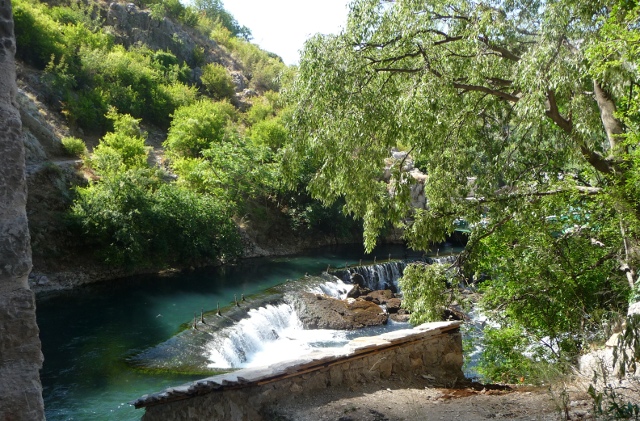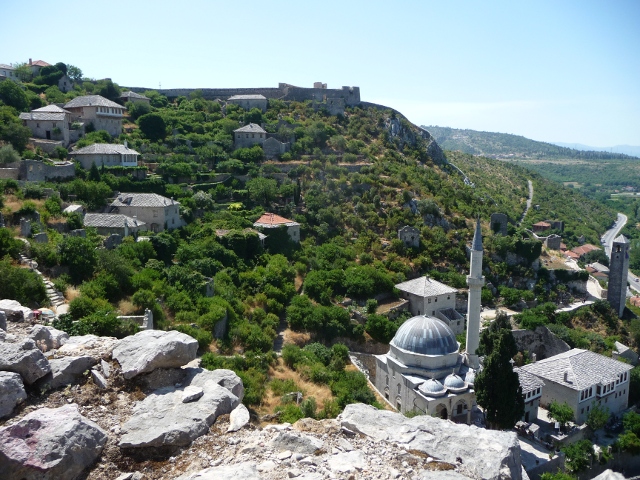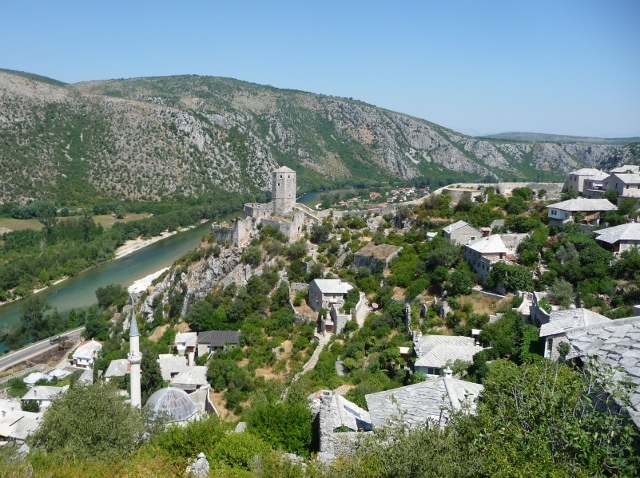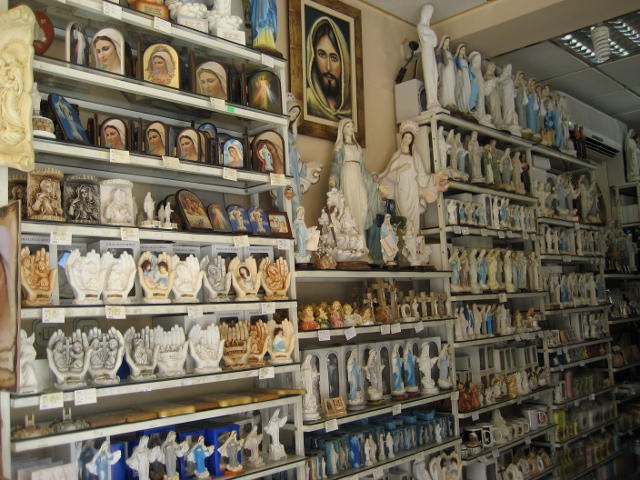After saying goodbye to Mostar, we had a little look at the village we’d been camped in. Apart from hosting half a dozen campsites, Blagaj is home to a Tekija, or Dervish monastery. Closely related to the Bektashi Muslims, whose spiritual home is Albania, and who we’d first come across in Macedonia, this monastery’s location was utterly gorgeous.
 The wood and stone house was beautiful in its simplicity, but as you looked out of the windows and saw the river passing beneath high cliffs and tumbling over small waterfalls, a sense of peace really did descend. Until, of course, you noticed the numerous restaurants and tat stalls spilling along the banks.
The wood and stone house was beautiful in its simplicity, but as you looked out of the windows and saw the river passing beneath high cliffs and tumbling over small waterfalls, a sense of peace really did descend. Until, of course, you noticed the numerous restaurants and tat stalls spilling along the banks.
It was then time to point the van back towards Dubrovnik for a bit – it felt a bit strange, almost a month and a half after we’d been there, but such is the circularity of this leg of our route. We didn’t get as far as the border back to Croatia, though – we were looking for a small village called Počitelj. Reputedly one of the most unspoiled Ottoman villages in the country, this really was a gem. Sure, there were a stack of coaches parked on the edge, but it was easy to get away from those doing a daytrip from their cruise liners – the village headed steeply up a hill, and that was all a bit strenuous for the cruise set…
 At the bottom of the village, a hammam joined the mosque and coaching inn to provide the focus of the village’s souvenir stalls. As you wound up the narrow, steep lanes towards the ancient fortress and the residential areas, the views of the river which provided the water for the Hammam improved no end.
At the bottom of the village, a hammam joined the mosque and coaching inn to provide the focus of the village’s souvenir stalls. As you wound up the narrow, steep lanes towards the ancient fortress and the residential areas, the views of the river which provided the water for the Hammam improved no end.
 At the top, we walked alone through the streets. Počitelj is no museum, though – after it had been (in the words of the information signs) “laid waste” during the war, it was quickly rebuilt as close to the original as possible, and most of the residents moved straight back in. As well as umpteen small cottages and mid-size houses, one of the original large Ottoman family houses remains, the home to an artist’s colony since the 1950s.
At the top, we walked alone through the streets. Počitelj is no museum, though – after it had been (in the words of the information signs) “laid waste” during the war, it was quickly rebuilt as close to the original as possible, and most of the residents moved straight back in. As well as umpteen small cottages and mid-size houses, one of the original large Ottoman family houses remains, the home to an artist’s colony since the 1950s.
We turned around, and started heading back north again. Međugorje promised us much, but failed to deliver anything at all. After Lourdes in the mid 19th century and Fatima in the early 20th, the Blessed Virgin Mary chose this small village in the middle of nowhere as the location for her next apparition, in the early 1980s. This time, six teenagers were lucky enough to see her. Somebody must have learned some lessons from Fatima, as all six are still alive and able to freely discuss their experiences. Three claim to still see her daily, whilst the other three are in reserve for special occasions. Whilst there is a large church surrounded by BVM tat-stalls, there was nothing of the over-the-top flamboyance of Fatima. The church was relatively small and plain, with only a long queue for confession as a clue of the village’s raison d’être. There was no massive barbecue of candlewax table-legs or bosoms. Even the tat was relatively restrained – although a BVM fridge magnet (with built-in thermometer) did briefly tempt us. Extremely briefly.
 After a long trawl across yet more beautiful countryside, we broke for the evening back at Jajce. Yes, the distant forest conflagration was still in full swing, nearly a week later, and had spread in several directions. On one side, it was now two hillsides further round, yet still nobody seemed overly bothered, so we shrugged and joined in their indifference. It had at least a week or two more before it reached the town. Probably. Looking at the map, we decided a different route, towards a different border point, made sense.
After a long trawl across yet more beautiful countryside, we broke for the evening back at Jajce. Yes, the distant forest conflagration was still in full swing, nearly a week later, and had spread in several directions. On one side, it was now two hillsides further round, yet still nobody seemed overly bothered, so we shrugged and joined in their indifference. It had at least a week or two more before it reached the town. Probably. Looking at the map, we decided a different route, towards a different border point, made sense.
The route we chose turned out to be another unsurfaced piste track, with a huge cloud of dust in our mirrors as we wound 50km or so between a couple of minor towns. Tiny villages were dotted around, all seemingly half-abandoned, with derelict shells of buildings outnumbering those which were inhabited. Serbian flags were everywhere. It was easy to presume that those pock-marked ruins may once have flown a different flag.
Eventually, we arrived at the border. Expecting a minor formality, we handed our passports to the Bosnian guard, and were out. The line moved forward, and we handed them to his Croatian opposite number in the next hut. He stared at the passports, and back at us. And again. He read our names out. Yes, that’s us. Another comparison. With brow furrowed, he turned round and passed them to the colleague behind him, responsible for those crossing the other way. The colleague turned, compared, repeated – and shrugged. A few words were exchanged between them. Did we have more ID? Our photocard driving licences were passed over. Fortunately, their expiry date (last month) wasn’t an issue. Again, much brow-furrowing and comparison. Did we have more ID? Umm, no… Move out of the line and park over there, please.
Oh. Umm…
We did so, and headed back to the hut on foot. The contrast between our pasty, chubby, neat-haired passport photos (mine not even 18 months old) and the reality after over a year in the van was clearly enough to have aroused his suspicions. Eventually, he decided that we were clearly doing a good enough job of disguising whatever our real identities were to make a hooky or stolen passport unlikely, so with another shrug he handed them back. We were in. As we drove out of the border crossing, we were laughing so hard that we completely missed the side road we should have taken. We only suspected something was amiss a good few km further on, wondering why we hadn’t reached the junction yet as we looked at the map on getting back in the van after taking pictures of Landmine warning signs…
Bosnia’s been an interesting country to visit. It’s trying to so hard to put the war behind it, but – ultimately – it just seems to be struggling to do so. Everywhere you go, the reminders are so fresh and so visible, in a way that they aren’t even in the northern bits of Macedonia, where the overspill of the Kosovan conflict was even more recent. Maybe it’s because it was so overwhelming, and maybe it’s because the rifts between the groups are still so deep?

